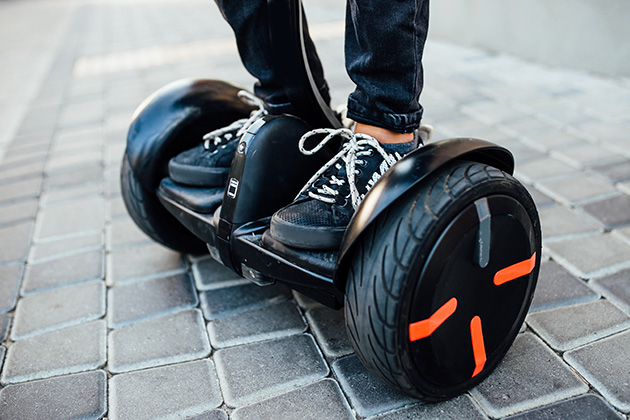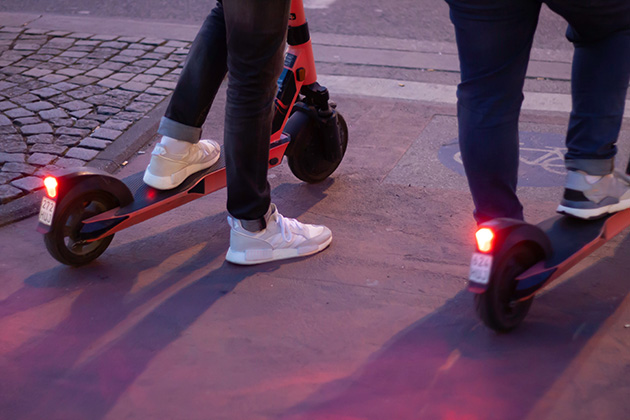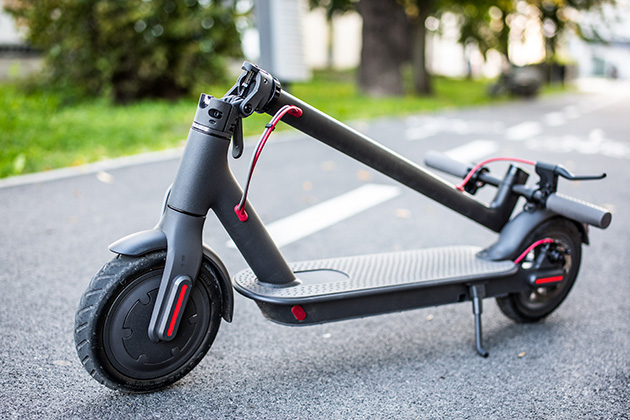7 January, 2022 By: Jane Hammond
Devices like e-scooters and e-skateboards are now legal to ride outside of private property in WA. So what are the rules and how will it impact the way we commute?
Electric scooters are one of the fastest growing forms of mobility in the world, beaten only by e-bikes.
Every day, thousands of Western Australians zip their way to the shops or the office on these and similar devices.
Yet despite the numbers, until December 2021, it had been illegal to ride these or the broader family of micromobility devices like e-skateboards, e- skates and e-unicycles, on roads and paths.
Under WA’s Road Traffic Code 2000, the use of devices with more than 200w of power or able to travel above 10km/h when propelled by the motor, was previously illegal. If an electric device could travel above 10km/h it could technically have been considered a ‘motor vehicle’. So, a rider could have been regarded as operating an unlicensed vehicle and there was a lack of clarity around how the device could be licensed for legal use.
Now, new road rules have paved the way for legal micromobility riding, while also acknowledging the risk of crashes with other road or path users and personal injury.

What are the rules you need to know?
The new rules apply to small electric rideable devices (classed together as eRideables), that are no more than 125cm long, 70cm wide and 135cm high, weigh 25kg or less, and are not capable of travelling faster than 25km/h when propelled by the motor on level ground.
To be considered an eRideable, the device must also have an electric motor or motors, be designed to be ridden by only one person, have at least one wheel, and have a stopping system controlled by brakes, gears, or motor control.
They don’t include e-bikes, the old-style Segway, motorised wheelchairs or low-powered scooters under 200w, which are covered elsewhere in the Code.
RELATED:
E-bikes available in WA in 2021 »
Under the rules, if an eRideable is ridden on an ordinary footpath, it must not exceed 10km/h. On shared paths and bicycle paths, and on local roads where the speed limit is 50km/h or less and there are no road markings, they can travel no more than 25km/h.
But they remain banned from travelling along roads with a speed limit above 50km/h, or where there is a dividing line or median strip down the centre, or on one-way roads with more than one marked lane. However, eRideables can be ridden in a bicycle lane, as long as the speed limit on the road is not more than 50km/h.
RAC manager, Road Safety Policy, Anita McCracken, says the organisation welcomes the decision to bring clarity to the legal status of eRideables, adding that the new rules provide guidance for how riders should interact with other road users.
“Our research shows that one in three members don’t feel safe sharing paths with these devices or with e-bikes,” McCracken says.
“We want to make sure that people can use them safely around different types of road users.
“They are becoming more common and whether they remain popular over the shorter or longer-term will be impacted by how well we manage them. It will be important to ensure the rules remain current and fit for purpose and a review of the new laws down the track should play an important role in this.”

How they can help manage congestion
The appeal of eRideables is clear.
Besides being fun to ride over flat ground, they offer a lightweight and relatively inexpensive option for commuters.
Many can fold up under a desk, travel in a lift, or, for those who split their commute, they can fit into a car boot or be taken on public transport - although there are some restriction in place for travel on public transport.
They also don’t require the same effort as traditional bikes, so riders might not need end-of-trip facilities or a shower, and because the rider stands, they don’t need to worry about work clothes getting tangled in chains.
They are also a far greener option than most other vehicles.
“These devices can reduce unnecessary vehicle trips, helping to manage congestion and reduce vehicle emissions as well,” McCracken says.
“According to the Department of Transport, around half of all car trips are less than five kilometres, so for short distances and commutes these devices really do offer a fantastic alternative.”
It’s perhaps not surprising, then, that Australian sales of micromobility devices, and e-scooters in particular, have soared.
The annual MetroCount census of cycling traffic shows the number of ‘short cycles’ (e-scooters and children’s bikes) doubled between 2018 and 2020 along the South Perth foreshore, with an estimated 20,000 trips now taking place a year.
While that’s substantial, other places in Australia have seen even greater growth. Hobart has seen almost a tripling of e-scooter numbers last year, and in some cases, they appear to be outnumbering traditional bikes in cycle lanes.
There are also around 1500 rideshare scooters in Canberra and similar numbers in Brisbane.
But with a wave of new riders, many of them adults who haven’t been on a scooter since childhood, there has also been a rising tide of rider and pedestrian injuries.
Statistics are mostly kept at the state or hospital level, but reports include nearly 800 injuries over 18 months in Brisbane from devices such as e-bikes, e-skateboards and hoverboards. The majority of injuries were from e-scooters that had been hired.
Finding a balance for safe eRideable use
Road Safety Commissioner Adrian Warner says WA’s new legislation strikes a balance between enabling riders to continue their love of eRideables and reducing the risk of injuries to riders or pedestrians.
“I predict that there is going to be a bit of a boom in these devices now we have some clarity on the laws,” he says.
“In WA we have some fairly good cycling and shared path infrastructure and we’re generally saying, where bikes can go, that’s where we want to guide eRideables.
“When you’re on those paths, it’s fair enough that you can travel up to 25km/h which is a similar speed to bicycles, but if you’re on a footpath or in a shared zone where there is likely to be more pedestrians you have to slow down to 10km/h.”
As with bicycles, riders also need to wear an approved helmet, and the device or rider must have reflectors and lights if being ridden where visibility is restricted (e.g. in poor weather or at night). Unless it’s not practicable to have one, the eRideable must have a bell or warning device fitted. Riders must not ride recklessly or without care and attention, or while under the influence of alcohol or drugs.
And while children under 16 are able to ride low-powered scooters that cannot exceed 10km/h when propelled by the motor, they cannot ride an eRideable with the power engaged.

Make sure the one you buy is legal to use in WA
If you’re considering buying an eRideable, WA Consumer Protection has warned buyers to do their homework.
Some models available for sale fall outside the guidelines and would still not be legal to operate on paths or roads, leaving riders at the risk of a fine if they break the rules.
A quick scan online shows some devices can travel far faster than the 25km/h maximum speed required under WA law, and not all have speed limiters as standard, while others fit the size restriction but not the weight.
Some second-hand scooters being sold have had speed limiters removed, meaning some can travel up to three times faster than the legal limit.

Warner says most retailers are doing the right thing.
“Many devices that we see, that are designed for the recreational and commuter market, have an inbuilt speedometer, have limiting devices and have push-button bells, so I think this is an example where, if you’re clear with the rules, the market will adjust,” he says.
The new rules are also likely to make it easier for WA to introduce ridesharing for e-scooters, which would have been impossible under the previous laws.
Community consultation by the Road Safety Commission in advance of the law change found 83 per cent of respondents were supportive of e-scooter rentals in WA.
Warner believes ridesharing could become an option, even if it means future adjustment might be needed to device weight and size limits.
And although many road users are still becoming used to e-scooters, over time he believes they will become a regular feature of the mobility mix.
“I think you'll see the uptake of these sort of personal mobility devices, particularly in places like Perth where there are over 200 days of sunshine a year,” he says.
“I think there'll be an increasing appetite from local governments and local communities to promote active and liveable streets, as opposed to thoroughfare roads, and these devices will have a very positive role to play in that regard.”
Reconnect WA
Find out how RAC is helping to revitalise streets and public spaces in WA to create more connected communities.
